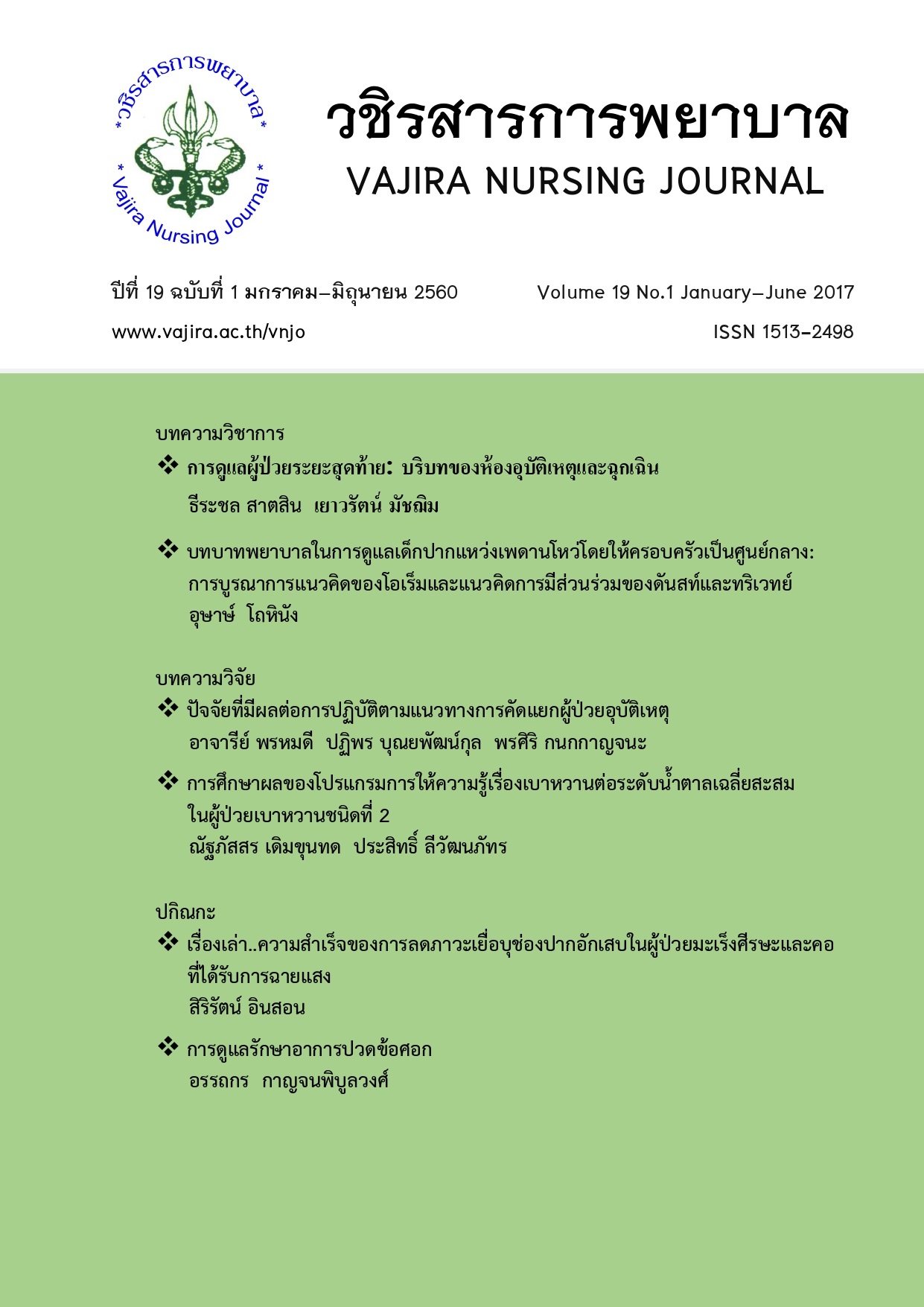การดูแลผู้ป่วยระยะสุดท้าย: บริบทของห้องอุบัติเหตุและฉุกเฉิน
Main Article Content
บทคัดย่อ
ถ้าหากคนเราสามารถเลือกสถานที่ตายได้ ทุกคนก็คงอยากตายดี ตายสงบ ปราศจากความทุกข์ทรมาน ความเจ็บปวด ตายด้วยจิตที่เป็นกุศล ท่ามกลางความอบอุ่นของครอบครัวหรือบุคคลอันเป็นที่รัก คงไม่มีใครอยากตายที่ห้องอุบัติเหตุและฉุกเฉิน แต่ในความเป็นจริงแล้วเราเลือกไม่ได้ ดังสัจธรรมที่ว่าเราเลือกเกิดไม่ได้ฉันใด เราก็เลือกสถานที่ตายไม่ได้ฉันนั้น ถ้าการตายดี ตายสงบปราศจากความทุกข์ทรมาน ความเจ็บปวดเป็นความปรารถนาของทุกคน การดูแลผู้ป่วยระยะสุดท้ายที่ห้องอุบัติเหตุและฉุกเฉินเป็นอีกหนึ่งความท้าทายสำหรับบุคลากรประจำห้องอุบัติเหตุและฉุกเฉิน
Article Details
เนื้อหาและข้อมูลในบทความที่ลงตีพิมพ์ในวชิรสารการพยาบาลถือเป็นข้อคิดเห็นและความรับผิดชอบของผู้เขียนบทความโดยตรง ซึ่งกองบรรณาธิการไม่จำเป็นต้องเห็นด้วย หรือร่วมรับผิดชอบใด ๆ ทั้งสิ้น
บทความ ข้อมูล เนื้อหา รูปภาพ ฯลฯ ที่ได้รับการตีพิมพ์ในวชิรสารการพยาบาล ถือเป็นลิขสิทธิ์ของวชิรสารการพยาบาล หากบุคคลใดหรือหน่วยงานใดต้องการนำทั้งหมดหรือส่วนหนึ่งส่วนใดไปเผยแพร่ต่อหรือเพื่อกระทำการใด ๆ จะต้องได้รับอนุญาตเป็นลายลักอักษรจากวชิรสารการพยาบาลก่อนเท่านั้น
เอกสารอ้างอิง
กิตติกร นิลมานัต. (2555). การดูแลระยะสุดท้ายของชีวิต. สงขลานครินทร์: ชานเมืองการพิมพ์.
ตึกเวชศาสตร์ฉุกเฉิน โรงพยาบาลวชิรพยาบาล. (2559). [ข้อมูลการให้บริการตึกเวชศาตร์ฉุกเฉิน โรงพยาบาลวชิรพยาบาล (Service Pofile)]. มปท.
ทองทิพย์ พรหมศร, สุดารัตน์ สิทธิสมบัติ และอัจฉรา สุคนธสรรพ์. (2551). การปฏิบัติการดูแลผู้ป่วยระยะสุดท้ายแบบประคับประคองของพยาบาลวิชาชีพ โรงพยาบาลฝาง จังหวัดเชียงใหม่. มหาวิทยาลัยเชียงใหม่, บัณฑิตวิทยาลัย.
ทัศนีย์ ทองประทีป. (2548). การดูแลผู้ป่วยระยะสุดท้ายในมิติจิตวิญญาณ. วารสารเกื้อการุณย์, 12(1), 31-39.
ภุชงค์ เหล่ารุจิสวัสดิ์. (2550). Psychiatic assessment and management in palliative care ในการดูแลผู้ป่วยระยะสุดท้าย (End of life care improving care of the dying). กรุงเทพฯ: โรงพิมพ์อักษรสัมพันธ์.
นันทวัน บุณยะประภัศร.(2542). สมุนไพรไม้พื้นบ้าน. บริษัทประชาชน, กรุงเทพฯ.
วราภรณ์ คงสุวรรณ, กิตติกร นิลมานัต, และเยาวรัตน์ มัชฌิม. (2557). อุปสรรคในการดูแลผู้ป่วยวิกฤตใกล้ตายที่ห้องฉุกเฉิน:ประสบการณ์ของพยาบาล. วารสารพยาบาลสงขลานครินทร์, 34(3), 97-108.
สภาการพยาบาล. (2558). Development of Palliative Care in Thailand : Present and Future. สืบค้นจากhttp://www.dms.moph.go.th/dmsweb/dmsweb_v2_2/Seminar/ Palliative_Care_and_Hospice_Care/data/02_26032558.pdf)
สุวคนธ์ กุรัตน์, พัชรี ภาระโข และสุวิริยา สุวรรณโคตร. (2556). การดูแลผู้ป่วยระยะสุดท้าย : มิติใหม่ที่ท้าทายบทบาทของพยาบาล. วิทยาลัยพยาบาลศรีมหาสารคาม: สถาบันพระบรมราชชนก สำนักงานปลัดกระทรวงสาธารณสุข กระทรวงสาธารณสุข.
Abu Hasheesh, M. O., AboZeid, S.A., El-Zaid, S.G., & Alhujaili, A. D. (2013). Nurses' characteristics and their attitudes toward death and caring for dying patients in a public hospital in Jordan. Health Science Journal, 7(4), 384-394.
Bailey, C., Murphy, R., & Porock, D. (2011). Professional tears: Developing emotional intelligence around death and dying in emergency work. Journal of clinical nursing, 20(23‐24), 3364-3372.
Barbera, L., Taylor, C., & Dudgeon, D. (2010). Why do patients with cancer visit the emergency department near the end of life?. Canadian Medical Association Journal, 182(6), 563-568.
Clarke, E. B., Curtis, J. R., Luce, J. M., Levy, M., Danis, M., Nelson, J., & Solomon, M. Z. (2003). Quality indicators for end-of-life care in the intensive care unit. Critical Care Medicine, 31(9), 2255-2262. doi:10.1097/01.ccm.0000084849.96385.85
Emanuel, L. L., von Gunten, C. F., & Ferris, F. D. (2000). Gaps in end-of-life care. Archives of Family Medicine, 9(10), 1176-1180.
Emergency Nurses Association. (2008). Competencies for nurse practitioners in emergency care. Emergency Nurses Association, Des Plaines, Ill, USA. Retrieve from http://aaenpnatl.org/images/downloads/Practice/compsfornpsinemergencycarefinal_ena.pdf.
Le Conte, P., Riochet, D., Batard, E., Volteau, C., Giraudeau, B., Arnaudet, I., . . . Potel, G. (2010). Death in emergency departments: A multicenter cross-sectional survey with analysis of withholding and withdrawing life support. Intensive Care Medicine, 36(5), 765-772. doi:10.1007/s00134-010-1800-1
McCaig, L. F., & Nawar, E. W. (2006). National Hospital Ambulatory Medical Care Survey: 2004 emergency department summary. Advance Data, 372, 1-29.
Mierendorf, S. M., & Gidvani, V. (2014). Palliative Care in the Emergency Department. The Permanente Journal, 18(2), 77-85. doi:10.7812/TPP/13-103
Nilmanat, K., & Phungrassami, T. (2006). Status of end of life care in Thailand. UICC World Cancer Congress. (pp. 8-12).
Prompahakul, C. Nilmanat, K. & Kongsuwan, W. (2011). Nurses’ Caring Behaviors for Dying Patients in Southern Thailand. Nurse Media Journal of Nursing, 1(2), 147-158.
Penman, J., Oliver, M., & Harrington, A. (2009). Spirituality and spiritual engagement as perceived by palliative care clients and caregivers. Australian Journal of Advanced Nursing, 26(4), 29.
Quest, T., Herr, S., Lamba, S., & Weissman, D. (2013). Demonstrations of clinical initiatives to improve palliative care in the emergency department: A report from the IPAL-EM Initiative. Annals of Emergency Medicine, 61(6), 661-667.
World Health Organization. (1996). Cancer control: knowledge into action: WHO guide for effective programmes (Vol. 2): World Health Organization. Retrieve from https://books.google.co.th/books?hl=en&lr=&id=3hVf8Ewh8xUC&oi=fnd&pg=PA2&dq=Cancer+control:+knowledge+into+action:+WHO+guide+for+effective+programmes+(Vol.+2)&ots=a7DCUw9ZWk&sig=RDQ1YdIKNXTtT9iZVf62M2bPgus&redir_esc=y#v=onepage&q&f=false.


